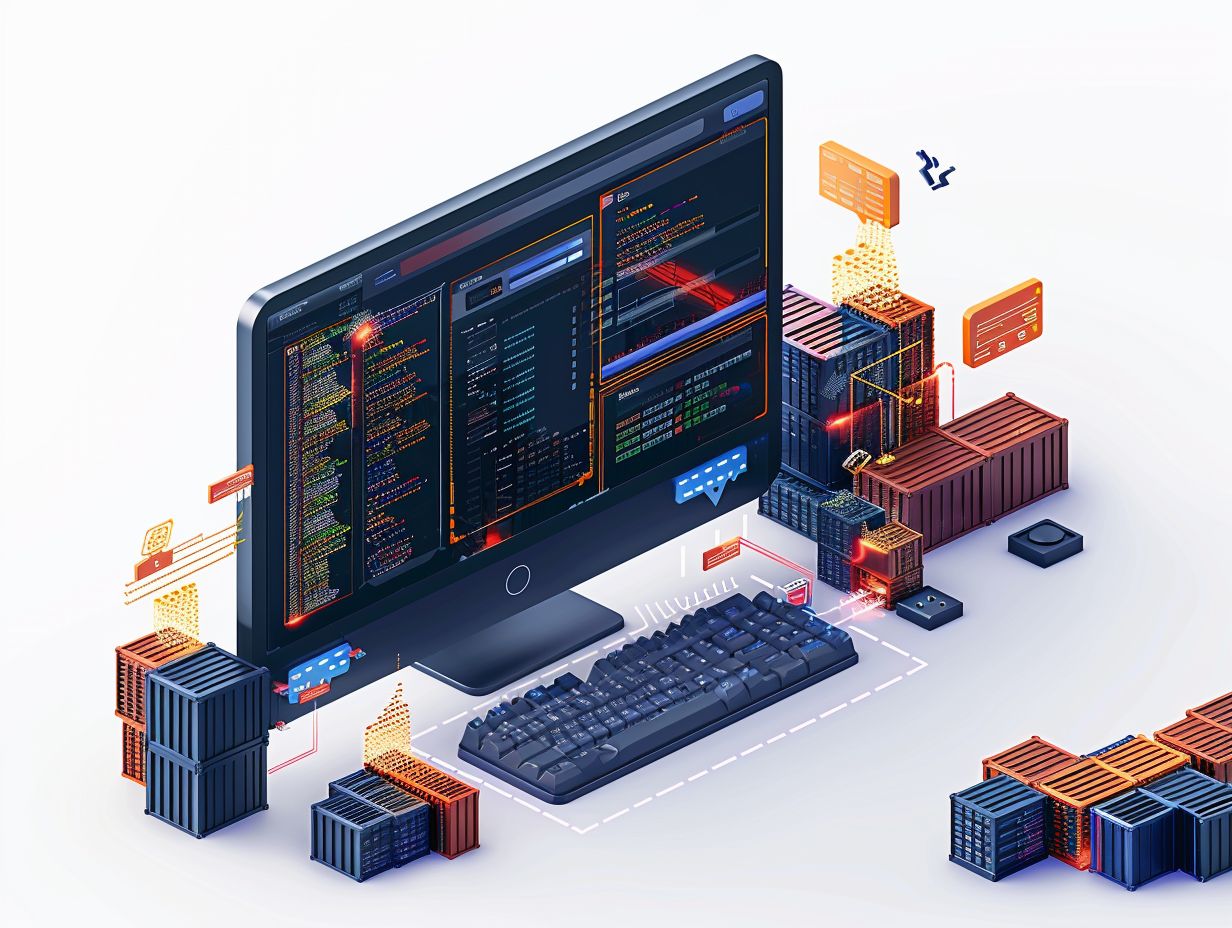Interested in learning about containerization in Linux and how it can benefit engineers?
Uncover the efficiency and scalability advantages of containerization, as well as its isolation and security features. Delve into popular tools like Docker and Kubernetes, and explore techniques such as container orchestration and image management.
Gain insights into best practices for optimizing performance, resource usage, and ensuring security and stability in a containerized environment. Let’s delve deeper into this topic!
Key Takeaways:

What is Containerization?
Containerization is a technology that enables you to create and deploy lightweight, isolated containers to run applications and services reliably and efficiently. It has transformed the way applications are developed, deployed, and managed across various platforms.
By encapsulating applications with their dependencies and configurations, containerization ensures consistency and portability, allowing you to build once and run anywhere. Docker, a widely-used containerization platform, simplifies the process of creating and managing containers. On the other hand, Kubernetes orchestrates these containers, automating deployment, scaling, and management. Red Hat plays a significant role in this ecosystem with its OpenShift platform, offering enterprise-grade Kubernetes solutions.
The container ecosystem provides flexibility, scalability, and improved efficiency, making it an essential component of modern software development practices.
Benefits of Containerization for Engineers
Engineers can leverage containerization technology to enhance application development, deployment, and security. By utilizing containers, you can isolate applications using namespaces and control groups, ensuring efficient resource utilization within a flexible and scalable architecture.
Efficiency and Scalability
The core benefits of containerization for modern infrastructure and application deployment include efficiency and scalability. Containers offer streamlined resource allocation, efficient cluster management, and seamless scalability across distributed environments.
By encapsulating applications and their dependencies, containers facilitate a consistent and reproducible deployment process. This not only enhances resource utilization by reducing overhead but also ensures swift and dependable application deployment. Containers are vital for effective cluster management, enabling efficient horizontal scaling and load balancing. This capability allows organizations to easily address dynamic workloads by dynamically provisioning and orchestrating containers to scale resources up or down based on demand.
Isolation and Security
In containerization, prioritizing isolation and security is essential to safeguard applications and data. Technologies like SELinux are pivotal in bolstering container security, establishing clear boundaries between containers and the underlying virtualization layer.
Implementing robust isolation mechanisms is crucial in containerization to mitigate security breaches and unauthorized access to sensitive data. SELinux, specifically, enforces mandatory access controls, restricting the actions permitted within containers.
Virtualization further strengthens security by isolating containers at the kernel level, confining any potential vulnerabilities within the specific container. This multi-layered approach significantly minimizes the risk of cyberattacks and data breaches, offering a robust defense for contemporary digital environments.
Tools for Containerization in Linux

In the realm of containerization, Linux presents a range of robust tools at your disposal, such as Podman, Skopeo, Buildah, and CRI-O. These tools serve to optimize the management and orchestration of containers specifically on Linux-based systems.
Docker
You should consider Docker as a leading open-source platform for containerization, which streamlines the development and deployment of applications by providing a standardized environment for packaging applications and their dependencies.
This standardized environment guarantees that applications operate consistently across various environments, simplifying the process of software development and testing. With Docker, you can create containers that package the application together with all its dependencies, including libraries and configurations, ensuring seamless operation on any machine. Thanks to Docker’s lightweight design and efficient resource sharing capabilities, it serves as an excellent option for microservices architecture, allowing developers to swiftly build, ship, and run applications.
Kubernetes
Kubernetes is a powerful orchestration tool for containerized applications that allows you to efficiently manage infrastructure and clusters. One of the notable features of Kubernetes is Operator Hub, which enhances the platform’s capabilities for automated operations.
Operator Hub is a crucial element in the Kubernetes ecosystem, serving as a centralized registry for Kubernetes operators – application-specific controllers that extend Kubernetes’ functionality. By utilizing these operators, you can automate intricate tasks and streamline application management. This automation not only minimizes manual intervention but also guarantees consistency and reliability in deployment and scaling procedures. Operator Hub facilitates the integration of third-party services and tools, enabling the seamless expansion of Kubernetes’ functionalities.
Techniques for Effective Containerization
Successful containerization depends on strong techniques like container orchestration and image management to optimize development processes and guarantee effective application deployment.
Container Orchestration
Utilizing container orchestration tools such as Kubernetes and Mesos simplifies the management of containerized applications by automating deployment, scaling, and monitoring tasks. These tools play a crucial role in ensuring the efficient orchestration of containers across diverse environments.
When you leverage Kubernetes or Mesos, your organization can optimize processes through automated scheduling, resource allocation, and load balancing. These tools offer a centralized platform for managing container clusters, guaranteeing resilience and high availability.
For example, Kubernetes provides self-healing capabilities and rolling updates, enabling applications to operate seamlessly without downtime. Conversely, Mesos excels in resource sharing and isolation, facilitating the efficient utilization of hardware resources for maximum performance.
By combining the strengths of these orchestration tools, organizations can effortlessly deploy and manage containerized applications with enhanced ease, scalability, and reliability.
Image Management

Effective image management involves utilizing tools like Docker and Red Hat Advanced Cluster Management to ensure seamless deployment and version control of container images. By managing images efficiently, your organization can uphold consistency and reliability in application deployments.
This systematic approach to image management eradicates the necessity for manual intervention, thereby reducing the likelihood of errors and guaranteeing that the application is deployed precisely as intended. Docker streamlines the process by bundling applications and their dependencies into standardized units called containers, while Red Hat Advanced Cluster Management offers additional functionalities for monitoring and overseeing containers at scale. These tools collaborate to streamline the deployment process, enhance security, and simplify the management of containerized applications.
Best Practices for Containerization in Linux
When implementing best practices in containerization for Linux, you should focus on optimizing performance, resource usage, and ensuring security and stability. By adhering to established best practices, organizations can enhance the reliability and efficiency of their containerized deployments.
Optimizing Performance and Resource Usage
Optimizing performance and resource usage in container environments involves employing efficient deployment strategies and appropriate resource allocation. By adjusting container configurations and scaling resources according to demand, you can attain optimal performance levels.
To achieve this, you need to have a thorough grasp of the application’s resource needs and the capacity to adapt resource allocation dynamically when required. Efficient deployment practices, including automated scaling and load balancing, are crucial to ensuring the smooth operation of containerized applications while preventing unnecessary resource wastage. By monitoring performance metrics and analyzing trends, organizations can make well-informed decisions to optimize resource utilization and improve overall efficiency in containerized environments.
Ensuring Security and Stability
To ensure security and stability in containerization, you need to implement robust measures to safeguard against vulnerabilities and maintain continuous operational stability. Technologies like SELinux are essential in enhancing container security and stability.
By incorporating security best practices such as least privilege access, secure communication channels, and regular vulnerability assessments, organizations can strengthen their containerized environments against potential threats. Stability mechanisms like resource monitoring, fault tolerance configurations, and automated scaling capabilities are crucial for upholding a reliable infrastructure for container deployments. SELinux, with its advanced access control policies and mandatory access controls, provides an additional layer of protection by confining container processes and restricting their interactions with the host system.
Frequently Asked Questions
What is containerization in Linux?

Containerization in Linux is the process of creating isolated environments called containers, which contain all the necessary components to run an application. This allows applications to be easily portable and scalable across different operating systems and hardware.
What are some commonly used tools for containerization in Linux?
Some popular tools for containerization in Linux include Docker, LXC, and Kubernetes. These tools provide an easy and efficient way to create and manage containers.
What are the benefits of using containerization in Linux for engineers?
Containerization in Linux offers several benefits for engineers, including improved portability and scalability, easier deployment and management of applications, and reduced resource usage. It also allows for better control and isolation of applications, leading to increased security.
Can containerization in Linux be used for any type of application?
Yes, containerization in Linux can be used for various types of applications, from simple web applications to complex enterprise applications. It offers a flexible and versatile solution for running and managing applications in different environments.
How does containerization in Linux differ from virtualization?
Containerization in Linux is often compared to virtualization, but there are some key differences. While virtualization creates multiple virtual machines on a single physical machine, containerization creates multiple containers on a single operating system. This results in better resource utilization and faster performance for containerization.
What are some best practices for using containerization in Linux?
Some best practices for containerization in Linux include keeping containers lightweight, using a minimal base image, regularly updating and monitoring containers, and properly managing storage and networking for containers. It is also important to follow security practices, such as limiting container privileges and using trusted images.
